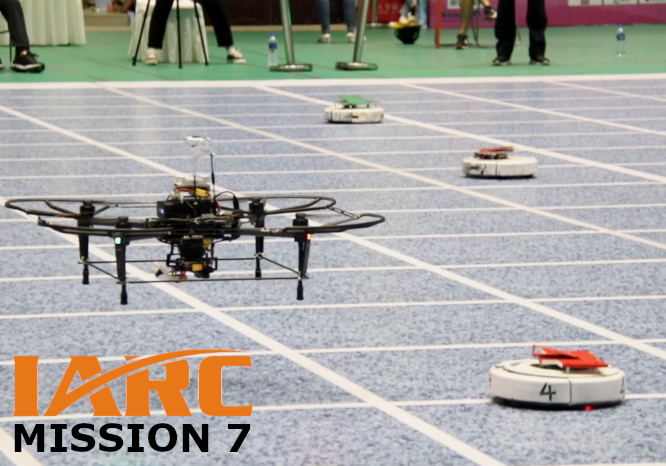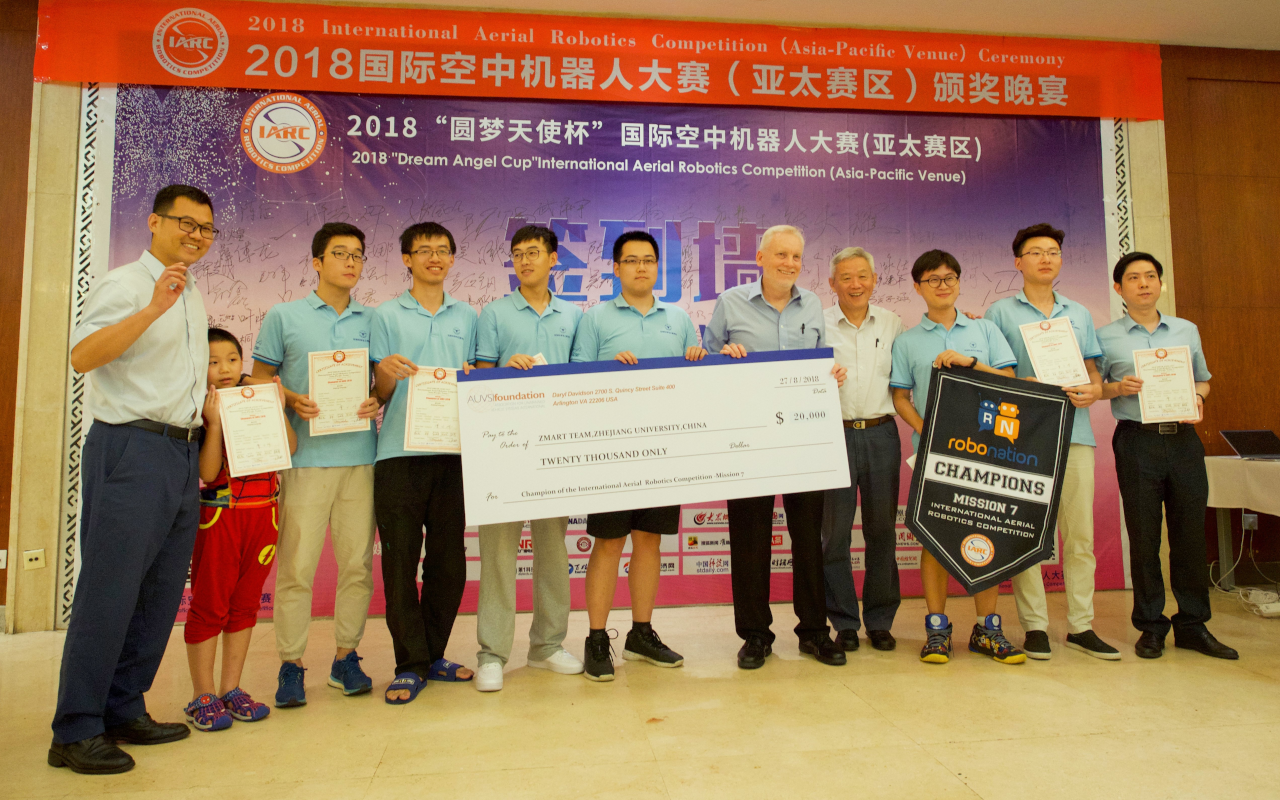
International Aerial Robotics Competition
During MISSION 7, teams demonstrated interaction between fully autonomous aerial robots and moving objects (specifically, autonomous ground robots), navigation in a sterile environment with no external navigation aids such as GPS or large stationary points of reference such as walls, and interaction between moving obstacles.
The 7th mission of the AUVSI Foundation’s (now "RoboNation") International Aerial Robotics Competition (IARC) was initially held at both of its venues on the campuses of the Georgia Institute of Technology (American Venue) and Beihang University (Asia/Pacific Venue) in August of 2014. That began the 21st year of continuous operation for the International Aerial Robotics Competition.
Without doubt, MISSION 7 has been the most challenging IARC mission to date. Over the past six missions, supportive technologies have been successively removed (first no GPS, then no SLAM) to the point that the fully autonomous aerial robots had to know where they were using solely "eye sight" just like a biological entity. No aerial robot existed which could perform the behaviors required by this mission statement, however as with all past missions, the Organizer, Judges, and Staff fully expected a university team to meet this challenge within the space of several years, thereby again advancing the state-of-the-art in aerial robotics.
Another distinctive of MISSION 7 was the requirement for the autonomous aerial robot to interact physically with numerous autonomous ground robots by touching them on top (commanding a 45° CW turn) or blocking their forward motion (commanding a 180° turn) intelligently so that the ground robots would change direction and ultimately be "herded" out one side of a rectangular arena. One problem for the aerial robots was the fact that the ground robots were programed to reverse direction periodically and also experience small random changes in direction (15° or less) so that they never went in a straight line for more than twenty seconds. To further increase the workload of the aerial robot, a series of four obstacles which had to be avoided, circled within the arena and caused collisions with the autonomous ground robots, further disrupting any predictability in their trajectories.
A prize award was set at $30,000 for the best performance which equaled or exceeded inducing four ground robots to leave the designated side of the arena. The 7th mission continued to adhere to the Competition’s long standing practice of posing tasks that cannot be completed with current technology and skills. As with previous missions, nothing within the world military or industrial arsenal of robots was able to complete the proposed mission at the time the guidelines were released.
After four years of development, a number of the over 50 teams entered in MISSION 7 were able to perform the autonomous behaviors required to win the competition, however due to its difficulty, the 10-minute time limit, and only four chances to demonstrate the requirement, the maximum number of ground robots that were able to be intentionally herded out of the arena was only 3. Analysis clearly showed that given extra attempts, the goal of 4 was certainly possible and that the desired technologies were amply demonstrated, so in 2018, the top prize was awarded to the top three performers: Zhejiang University ($20,000); Xiamen University ($6,000); and the Harbin Institute of Technology ($4,000).
In the top performances, which were replicated multiple times, the Zhejiang University team showed that its autonomous aerial robot could track individual ground robots, redirect them in either 45° increments by touching them on the top or causing a direction reversal of 180° by landing in front of their path to block them while at the same time staying within the arena boundaries and avoiding the mobile obstacles circulating within the arena. The Zhejiang aerial robot would survey the arena and then choose likely candidate ground robots to track. Once locked onto a ground robot, it would reorient it, follow it, and when the ground robot was just about to change direction, the aerial robot would block the last few seconds of progress toward the goal line causing a reversal in direction away from the line. This seems counterintuitive, however the aerial robot was using the known timing of the ground robot reversals as specified in the Official Rules, to reverse its direction immediately before it would have reversed direction on its own. This resulted in the ground robot reversing 180° under the influence of the collision with the Zhejiang aerial robot, and then immediately reversing 180° again of its own accord -- the result being that the ground robot stopped, did a 360° rotation, and then continued along its path to the goal line. The Zhejiang aerial robot would then follow the ground robot until the next reversal was about to occur, whereupon the process was repeated until the ground robot crossed the line. This intelligent strategy was successful and entirely what the IARC organizers had hoped to see. The stochastic geometry of the ground robot field factored into the time required to complete the task as did the relatively slow speed of the ground robots. As such, the maximum number of ground robots that could be intentionally herded in the 10-minute run interval was only 3 (not including those that found their own way to an boundary edge and were removed from play).

 Alexandria Institute of Engineering & Technology: Alexandria, Egypt
Alexandria Institute of Engineering & Technology: Alexandria, Egypt Beihang University: Haidian District, Beijing, China
Beihang University: Haidian District, Beijing, China Birla Institute of Technology & Science - Pilani: Dubai, United Arab Emirates
Birla Institute of Technology & Science - Pilani: Dubai, United Arab Emirates California State University, Northridge: Northridge, California, United States
California State University, Northridge: Northridge, California, United States Civil Aviation University of China: Tianjin, Shandong, China
Civil Aviation University of China: Tianjin, Shandong, China Delhi Technological University: New Delhi, Delhi, India
Delhi Technological University: New Delhi, Delhi, India Embry-Riddle Aeronautical University: Daytona Beach, Florida, United States
Embry-Riddle Aeronautical University: Daytona Beach, Florida, United States Georgia Institute of Technology: Atlanta, Georgia, United States
Georgia Institute of Technology: Atlanta, Georgia, United States Harbin Engineering University: Harbin, Heilongjiang, China
Harbin Engineering University: Harbin, Heilongjiang, China Hindustan University of Technology & Science: Chennai, India
Hindustan University of Technology & Science: Chennai, India Hong Kong University of Science & Technology: Kowloon, Hong Kong
Hong Kong University of Science & Technology: Kowloon, Hong Kong Indian Institute of Technology, Kharagpur: Kharagpur, West Bengal, India
Indian Institute of Technology, Kharagpur: Kharagpur, West Bengal, India International University of Chabahar: Chabahar, Iran
International University of Chabahar: Chabahar, Iran Islamic Azad University of Najafabad: Najafabad, Iran
Islamic Azad University of Najafabad: Najafabad, Iran Istanbul Technical University: Istanbul, Turkey
Istanbul Technical University: Istanbul, Turkey Kennesaw State University: Marietta, Georgia, United States
Kennesaw State University: Marietta, Georgia, United States Marshal Suryadarma Aerospace University: Jakarta, Indonesia
Marshal Suryadarma Aerospace University: Jakarta, Indonesia  Massachusetts Institute of Technology: Cambridge, Massachusetts, United States
Massachusetts Institute of Technology: Cambridge, Massachusetts, United States Missouri University of Science & Technology: Rolla, Missouri, United States
Missouri University of Science & Technology: Rolla, Missouri, United States Nanjing University of Aeronautics & Astronautics: Nanjing, Jiangsu, China
Nanjing University of Aeronautics & Astronautics: Nanjing, Jiangsu, China National Taiwan University of Science & Technology: Taipei, Taiwan
National Taiwan University of Science & Technology: Taipei, Taiwan Naval Aeronautical and Astronautical University: Yantai, Shandong, China
Naval Aeronautical and Astronautical University: Yantai, Shandong, China Ningxia University: Yinchuan, China
Ningxia University: Yinchuan, China North Dakota State University: Fargo, North Dakota, United States
North Dakota State University: Fargo, North Dakota, United States Northeastern University: Shenyang, Liaoning, China
Northeastern University: Shenyang, Liaoning, China Norwegian University of Science & Technology: Trondheim, Norway
Norwegian University of Science & Technology: Trondheim, Norway Old Dominion University: Norfolk, Virginia, United States
Old Dominion University: Norfolk, Virginia, United States Oregon State University: Corvallis, Oregon, United States
Oregon State University: Corvallis, Oregon, United States PES University: Bangalore, Karnataka, India
PES University: Bangalore, Karnataka, India Pima Community College: Tucson, Arizona, United States
Pima Community College: Tucson, Arizona, United States Polytechnique Montréal: Montréal, Québec, Canada
Polytechnique Montréal: Montréal, Québec, Canada Pokhara University: Lalitpur, Nepal
Pokhara University: Lalitpur, Nepal Purdue University: West Lafayette, Indiana, United States
Purdue University: West Lafayette, Indiana, United States Sahyadri College of Engineering & Management: Mangalore, Karnataka, India
Sahyadri College of Engineering & Management: Mangalore, Karnataka, India St. Olaf College / Carleton College: Northfield, Minnesota, United States
St. Olaf College / Carleton College: Northfield, Minnesota, United States South Dakota School of Mines and Technology: Rapid City, South Dakota, United States
South Dakota School of Mines and Technology: Rapid City, South Dakota, United States Sun Yat-Sen University: Guangzhou, Guangdong, China
Sun Yat-Sen University: Guangzhou, Guangdong, China Temasek Polytechnic: Singapore
Temasek Polytechnic: Singapore Tsinghua University: Beijing, Beijing, China
Tsinghua University: Beijing, Beijing, China Universidad Politécnica de Madrid: Madrid, Spain
Universidad Politécnica de Madrid: Madrid, Spain University of Alabama in Huntsville: Huntsville, Alabama, United States
University of Alabama in Huntsville: Huntsville, Alabama, United States University of California, San Diego: La Jolla, California, United States
University of California, San Diego: La Jolla, California, United States University of Central Florida: Orlando, Florida, United States
University of Central Florida: Orlando, Florida, United States University of Louisville: Louisville, Kentucky, United States
University of Louisville: Louisville, Kentucky, United States University of Michigan: Ann Arbor, Michigan, United States
University of Michigan: Ann Arbor, Michigan, United States University of Nebraska - Lincoln: Lincoln, Nebraska, United States
University of Nebraska - Lincoln: Lincoln, Nebraska, United States University of Ottawa: Ottawa, Ontario, Canada
University of Ottawa: Ottawa, Ontario, Canada University of Pennsylvania: Philadelphia, Pennsylvania, United States
University of Pennsylvania: Philadelphia, Pennsylvania, United States University of Pittsburgh: Pittsburgh, Pennsylvania, United States
University of Pittsburgh: Pittsburgh, Pennsylvania, United States University of Texas at Austin: Austin, Texas, United States
University of Texas at Austin: Austin, Texas, United States Xiamen University: Xiamen, Fujian, China
Xiamen University: Xiamen, Fujian, China Zhejiang University: Hangzhou, Zhejiang, China
Zhejiang University: Hangzhou, Zhejiang, China